Tag Archives: natural disasters
Kansas militia expects zombies, and it’s dead serious
It’s got to be one of the coolest names ever for a group:
The Kansas Anti Zombie Militia.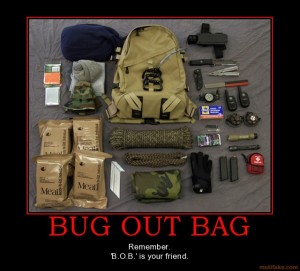
But the group is real and its members are pretty serious about it.
Once the Zombie Apocalypse hits, they’ll be ready for it and they want you to be too.
“Can a natural person change into this monster that many fear?” Alfredo Carbajal, the militia’s main spokesman, said in an interview. “The possibilities are yes, it can happen. We have seen incidents that are very close to it, and we are thinking it is more possible than people think.”
Carbajal and other true believers aren’t so much scared of movie zombies. The apocalypse they see coming is a pandemic spread by a virus that creates zombie-like symptoms.
Last month, the Discovery Channel featured the Kansas militia in a documentary that concluded that such a Zombie Apocalypse — or Zompoc — was possible. The program featured scientists who speculated some evolving virus is bound to jump to humans on our overcrowded planet.
Of course, scientists have been warning about pandemics such as bird flu that don’t produce zombies, but zombies are the hot monsters right now.
A packed house listened last year at St. Mary’s College of Maryland as a chemist, psychologist and student acknowledged the possibility of an epidemic, according to the school’s newspaper.
The panel pointed out that there already have been zombie-like symptoms dating back to 1594; they were eventually determined to be the first recorded human case of furious rabies — an especially serious form of rabies.
Carbajal, 28, didn’t start out as a zombie fighter.
He and several friends grew up in Wamego, home of the Oz museum, watching zombie movies like “Shaun of the Dead,” “28 Days Later” and “Night of the Living Dead” and playing video games like the Left 4 Dead video game series.
The friends designed a web page for fun but then they began wondering what to do if there was actually a zompoc, and their thinking turned serious.
The group has five founders but about 1,500 likes on its Facebook page.
It’s not all zombie crusading; the militia also sponsors a Zombie Walk in October to raise money and food for charities.
But the group’s website points out that the militia is committed to research and preparing for a zompoc.
“We are not crazy. We are not paranoid. We believe in preparedness in any situation,” it says.
Everything you need to know about surviving a zombie attack can be found on the militia’s website — never take on a small horde of zombies by yourself because that would be suicide, and make sure all your skin is covered because blood spatters can be infectious.
Blunt objects are better to use than, say, knives because blades tend to dull after each use. A metal bat and a collapsible baton are the two most recommended weapons.
The site also notes as “a real-life threat to humanity” a biosecurity lab planned near Manhattan, Kan.
Carbajal and his group are not alone in their deep fascination over zombies. Much of the country has been touched.
The “Walking Dead” cable series broke basic cable ratings records with more than 10 million viewers for the first show of season three. And already hype for a movie, based on the book “World War Z,” is widespread even though its release date is six months out.
How-to books have been published in recent years, including the “Zombie Survival Guide,” which made the New York Times Best Seller List, and the “Zombie Combat Manual,” which warns “During a zombie outbreak, 98% of individuals will have to destroy an undead opponent without the aid of a firearm. Will you be ready?”
Carbajal said that if you aren’t a true believer, just being prepared for any apocalypse or natural disaster is a good thing.
“My thought is if you are ready for zombies, you are ready for anything, whether it be natural disasters, fall of government, invasion from another country — the possibilities are endless,” he said. “The point is to keep yourself and your loved ones safe.”
Others agree.
Using the guise of a zombie apocalypse, the Centers for Disease Control and Prevention and state emergency management agencies are trying to get people to be prepared for a natural disaster with at least several days of food and supplies, copies of important documents and a plan.
“It’s a spoof; we are not encouraging a zombie scare,” said Devan Tucking-Strickler, Kansas Division of Emergency Management spokeswoman. “We use the tagline, ‘If you are prepared for zombies, you are prepared for anything and prepared for the unexpected.’ ”
Kansas even used the militia to help promote general disaster awareness.
Members of the group were featured in a photograph with Gov. Sam Brownback when he signed a proclamation declaring October as Zombie Preparedness Month in Kansas.
A little preparation for disaster can prove very important later, but most people don’t prepare, said another viral disaster worrier, Shawn Beatty, who also was featured on the Discovery documentary.
“You can get a first aid kit for $100, something that you should have in your house anyway, or you can go to dinner, take a trip, or have a really nice night out with that $100,” said Beatty, a public-school teacher in Columbia. “Who is going to say, ‘Let’s go buy something that you may not use?’
Doomsday 2012 Fact Sheet
 There is widespread and unnecessary fear of doomsday on December 21, 2012. Some people worry about a Maya prophesy of the end of the world, others fear a variety of astronomical threats such as collision with a rogue planet. Opinion polls suggest that one in ten Americans worry about whether they will survive past Dec 21 of this year, and middle-school teachers everywhere report that many of their students are fearful of a coming apocalypse. Following are brief facts that address these doomsday fears.
There is widespread and unnecessary fear of doomsday on December 21, 2012. Some people worry about a Maya prophesy of the end of the world, others fear a variety of astronomical threats such as collision with a rogue planet. Opinion polls suggest that one in ten Americans worry about whether they will survive past Dec 21 of this year, and middle-school teachers everywhere report that many of their students are fearful of a coming apocalypse. Following are brief facts that address these doomsday fears.
Mayan Calendar: The Maya calendar, which is made up different cycles of day counts, does not end this year. Rather, one cycle of 144,000 days (394 years) ends and the next cycle begins.
Mayan Prophecy: The ancient Maya did not predict the end of the world or any disaster in December 2012. Such doomsday predictions are a modern hoax.
Planet Nibiru: Nibiru is probably the minor name of a god found in ancient Mesopotamian writing. There is no planet named Nibiru, and the fictional books by economist Zecharia Sitchin about a civilization on this planet are a hoax.
Rogue Planet Headed for Earth. For the past decade there have been reports of a rogue object (Planet X, or Nibiru, or Hercubolus, or even Comet Elenin) that will collide with Earth in December 2012. These claims are not true. If such a threatening world existed, it would be one of the brightest objects in the sky, and astronomers would have been tracking it for years. If it existed, its gravity would be distorting the orbits of planets, especially Mars and Earth. Astronomers know that it does not exist.
Planet Alignments: There is no alignment of planets in Dec 2012. There is an approximate lining up of the Earth and Sun and the center of our Galaxy in late December, but this happens every year. In any case, planet alignments have no effect on the Earth.
Pole Shift: There is nothing strange this year about either the magnetic poles or the rotational poles of the Earth. The magnetic polarity changes every million years or so, but that is not happening now, and it probably takes thousands of years when it does happen. A sudden change in the rotational axis has never happened and is not possible. If there were any change in the Earth’s rotation, it would be instantly apparent by failure of our GPS systems.
Increasing Disasters. Our planet is behaving normally in 2012, although we see more and more news stories about natural disasters. There has been no increase in earthquakes or volcanic eruptions. There has been an increase in extreme weather, including both droughts and floods, which are partly attributable to global warming, but this has nothing to do with a 2012 doomsday.
Solar Outbursts: The Sun’s ongoing 11-year activity cycle is expected to peak in 2013, not 2012. Solar outbursts (flares and CMEs) can damage orbiting satellites but will not hurt us on the surface. The strength of the 2013 solar maximum is predicted to be lower than average, not higher.
Bunker Conspiracy: Accusations of a massive government cover-up are nonsense. No government could hide an incoming planet or silence hundreds of thousands of scientists. Rumors that huge bunkers have been built in the U.S. or elsewhere to shelter the elite are lies. Apparently a few people are building private shelters, but their fear of 2012 is misplaced and they are wasting their money.
Scaring Children: The group most vulnerable to doomsday claims is children. Teachers report that many of their students are frightened and some are even considering suicide. This is the most tragic consequence of the 2012 hoax.
The End of the World: The idea of the sudden end of the world by any cause is absurd. The Earth has been here for more than 4 billion years, and it will be several more billion years before the gradual brightening of the Sun makes our planet unlivable. Meanwhile there is no known astronomical or geological threat that could destroy the Earth.
Cosmophobia: Many young people write to me that they are scared of astronomy. When they read about some new discovery, the first thing they think is that it might hurt them, even if it is happening in a distant galaxy. There is no reason for such fears, which I call cosmophobia (fear of the universe). This rash of concern seems to be the result of too many conspiracy theories and sensational stories featured on the Internet and irresponsible news outlets. Astronomical objects are so distant that they cannot threaten the Earth. Please don’t be afraid of the Sun or the planets or comets or asteroids. The universe is not your enemy.
DOOMSDAY 2012 – NATURAL DISASTERS COULD WIPE OUT YOUR ZOMBIE WORRIES
Floods, earthquakes, and volcanic eruptions. These are just a few of the natural disasters that may befall our planet between now and December 21st, 2012. As we speak, the summer solstice is upon us, but it’s the winter solstice that we should be worrying about.
Flooding. There are several different scenarios in which massive floods may overcome our planet. One is oceanic rise. If the oceans rise, the coastal areas of the world will recede, and millions of people living in these areas will either die or have to move further inland. Global warming is currently being blamed for the Greenland ice sheets and polar cap melt off that has been going on for years. I think the majority of people are skeptical of this diagnosis, or just don’t know what to think, as scientists seem to fall on both sides of this debate. What no one can dispute is that this is happening.
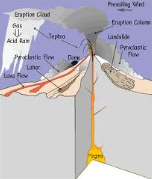
If solar flare/sunspot activity on 12/21/2012 should be great enough to gain entrance to our atmosphere on this day, it could accelerate the ice melt and the oceans will rise. If the temperature of the earth’s surface rises just a few degrees, this would also happen. How quickly, obviously no one knows. One thing rapid or even gradual ice melts will do is disrupt the thermohaline circulation of water in the Atlantic Ocean, an ocean-based system of heat delivery sometimes referred to as the North Atlantic thermal conveyor belt.
The northeastern States, eastern Canada and, primarily, Europe enjoy warmer climates than they otherwise would because of the thermohaline circulation. This vast ocean conveyor sweeps warm, salty water from tropical latitudes north along the surface. After shedding heat to the atmosphere, the chilled brine becomes denser and sinks. Thousands of feet beneath the surface it flows back toward the equator, completing the loop.
But as the climate warms disproportionately at the poles, the gears of the system begin to wobble. Freshwater runoff from Greenland’s ice cap and from melting glaciers across the Arctic, combined with increased precipitation, will form a thick, buoyant cap over the North Atlantic. Already, this gigantic vortex may be sputtering. The surface of the North Atlantic is becoming noticeably less salty, and thus less driven to sink.
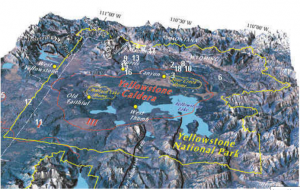 Thermohaline circulation shut down as recently as 8200 years ago, and some scientists contend that the Little Ice Age of 1300 to 1850 was due to a hiccup in the system. The chance of another collapse is hotly debated, in scientific circles, and may throw us into another Little Ice Age again.
Thermohaline circulation shut down as recently as 8200 years ago, and some scientists contend that the Little Ice Age of 1300 to 1850 was due to a hiccup in the system. The chance of another collapse is hotly debated, in scientific circles, and may throw us into another Little Ice Age again.
Earthquakes are a distinct possibility, and tectonic shift may occur. Tectonic shift and rise can be a direct result of earthquakes, as well as the weight and motion of melting water, among other things. It may well force the earth’s mantle to rise up and reform our planet.
Volcanic eruptions are a potentially catastrophic event that could be in store for us. The caldera at Yellowstone National Park, the World’s largest volcano, is said by scientists to be overdue for an eruption. This volcano is sometimes referred to as a Super volcano. There are over 3000 recorded earthquakes at Yellowstone National Park each year, and any sort of cataclysmic event on a worldwide scale may be the spark that  forces the caldera to erupt. That eruption, along with any others that may happen on that fateful day, 12/20/2012, would put enough volcanic ash into the atmosphere, as to blot out the sun for years, perhaps even decades. And then there are all the different types of gasses that will also be in the air, and oxygen purity levels will drop dramatically. Without Photosynthesis, a process whereby plants capture the suns energy to split off water’s hydrogen from oxygen. Hydrogen is combined with carbon dioxide to form glucose and release oxygen. If the sun is blotted out and plants can’t grow and capture carbon dioxide, while releasing oxygen, we may lose our ability to breath, among other things. This will also have a devastating effect on the global food chain. In my opinion, this will be the start of a fatal global downward spiral, from which there will be no return.
forces the caldera to erupt. That eruption, along with any others that may happen on that fateful day, 12/20/2012, would put enough volcanic ash into the atmosphere, as to blot out the sun for years, perhaps even decades. And then there are all the different types of gasses that will also be in the air, and oxygen purity levels will drop dramatically. Without Photosynthesis, a process whereby plants capture the suns energy to split off water’s hydrogen from oxygen. Hydrogen is combined with carbon dioxide to form glucose and release oxygen. If the sun is blotted out and plants can’t grow and capture carbon dioxide, while releasing oxygen, we may lose our ability to breath, among other things. This will also have a devastating effect on the global food chain. In my opinion, this will be the start of a fatal global downward spiral, from which there will be no return.
Last but not least. Again, in my opinion, the most probable occurrence will be an eruption of the volcano at Cumbre Vieja. Cumbre Vieja is an active volcanic ridge on the volcanic ocean island of Isla de La Palma in the Canary Islands, Spain. History has recorded volcanic eruptions of the Cumbre Vieja in 1470, 1585, 1646, 1677,m 1712, 1949, and 1971.
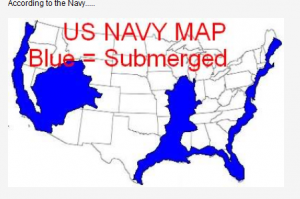 During the 1949 eruption, three vents—Duraznero, San Juan and Hoyo Negro—opened and expelled massive amounts of lava. Also during the eruption two earthquakes happened centered near Jedey. Following the earthquakes a fracture appeared, approximately two miles long, about 1/10 of the exposed length of the Cumbre Vieja. Parts of the western flank of the Cumbre Vieja ridge moved about 1 mile sideways and 2 miles downwards towards the Atlantic Ocean. Scientists have hypothesized that an eruption or even an earthquake would send the western flank of the island sliding into the Atlantic Ocean, creating a Mega Tsunami of biblical proportions. Computer models indicate the resulting gravitational landslide will enter the Atlantic Ocean and create the so called Mega Tsunami, with the initial wave estimated at some 200 feet in height, and a peak to peak height of 1 mile. Estimated speed of the wave is 600 mph. It will reach the African coast in 1 hour, southern england in about 3 to 4 hours, and the eastern seaboard of the United States in about 6 hours. The initial wave will have subsided into a succession of smaller ones each about 100 to 200 feet in height, and may swell to 400 to 600 feet high at a distance of 1 to 2 miles apart, while retaining the original speed. Computer models indicate differing inland inundation measurements, between 15 to 30 miles or more according to the volume of water.
During the 1949 eruption, three vents—Duraznero, San Juan and Hoyo Negro—opened and expelled massive amounts of lava. Also during the eruption two earthquakes happened centered near Jedey. Following the earthquakes a fracture appeared, approximately two miles long, about 1/10 of the exposed length of the Cumbre Vieja. Parts of the western flank of the Cumbre Vieja ridge moved about 1 mile sideways and 2 miles downwards towards the Atlantic Ocean. Scientists have hypothesized that an eruption or even an earthquake would send the western flank of the island sliding into the Atlantic Ocean, creating a Mega Tsunami of biblical proportions. Computer models indicate the resulting gravitational landslide will enter the Atlantic Ocean and create the so called Mega Tsunami, with the initial wave estimated at some 200 feet in height, and a peak to peak height of 1 mile. Estimated speed of the wave is 600 mph. It will reach the African coast in 1 hour, southern england in about 3 to 4 hours, and the eastern seaboard of the United States in about 6 hours. The initial wave will have subsided into a succession of smaller ones each about 100 to 200 feet in height, and may swell to 400 to 600 feet high at a distance of 1 to 2 miles apart, while retaining the original speed. Computer models indicate differing inland inundation measurements, between 15 to 30 miles or more according to the volume of water.
This would greatly damage or destroy cities along the entire North American eastern seaboard, and tens of millions would be killed from Maine to Florida, and everything In between.
So there you have it. Not a pretty picture is it.
Apocalypse NOW! Surviving the Doomsday Polar Shift in an Inland Lifeboat
Because the STATIM pods are modular, you can customize them for your particular nightmare scenario.
First things first. Before worrying about food storage or access to clean water during a major disaster, you need to make sure you get through the first wave safely. But never fear: When the next big tsunami hits, a water-ready modular bunker called the STATIM pod aims to float you above the flooding.
Invented by Miguel Serrano, President at Brahman Industries, the STATIM (Storm, Tornado And Tsunami Interconnected Modules) pods are designed to withstand the awesome power of tsunamis, while giving survivors a fighting chance in the aftermath.
Brahman Industries calls the pods “inland lifeboats.” The reason: they’re buoyant and self-righting, so when the floods come, they will bob to the surface. They’re also low-tech, easy to maintain, and easy to construct, which means there’s a possibility for wide deployment. The company’s plan is to install and anchor them in flood-prone areas so when the alarm bells ring, those most at risk can rush to the safety of the pods. Inside, up to 50 people can cling to secure seating arrangements.
It’s the end of the world, but this guy is feeling fine.
The biggest issue with rescue-shelter design is always cost. We already know how to make structures that can withstand natural disasters; it’s just incredibly expensive. The key to keeping costs down is using concrete, a cheap and well-understood building material. “We’re addressing a high-priority need with a low tech approach,” says Serrano. When STATIM reaches scale, Serrano aims to offer the 50-person pod at around $1,800 a head.
The tubular hull is made from a series of pre-cast concrete modules. The modules can be created at local factories, shipped separately, and then aligned and winched together on site to create a watertight seal. “Everyone knows how to do this,” says Serrano. According to the company, the assembly process for the pre-cast parts requires about the same amount of knowledge as installing a drain system.
A STATIM pod waits to be assembled.
The pod continues to serve the people inside long after the first wave of disaster. “After Katrina, they spent three weeks just rescuing people with helicopters,” Serrano says. Because the pods are buoyant and equipped with communications devices, rescuers will be able to easily meet up with the pods to tow them away. A boat or helicopter can transport 50 people at a time to safety.
And because the parts are modular, the pods are customizable. By including different segments equipped with all kinds of survival gear, your personal STATIM pod can be modded to your anticipated needs.
The next step, says Serrano, is creating pods that house critical infrastructure. The company has proposed a variation on STATIM called the Genset, which houses working generators. Having survivable power sources would have prevented the Fukushima meltdown, Serrano says, by providing power to the nuclear plant’s critical systems after the tsunami. Other variations include pods with desalination facilities and a version of the pod that can withstand an EMP blast, ensuring that critical electronics would survive a nuclear strike.
The eerily calm diagrammatic disaster illustration. Not pictured: STATIM occupants bracing before nature’s fury.
While the intention of the STATIM system is that they be temporary shelters, let’s indulge ourselves in a little bit of design fiction for a moment. What about the pod’s potential to facilitate long-term living in environmentally extreme places?
As the seas rise and cities fall, imagine a community of these built and arranged in new flood zones, perhaps for scientists seeking to learn about new littoral urban ecosystems or salvagers prospecting for the remaining treasures of a lost civilization. Every night, the tribe would return to their STATIM homes, sleeping soundly with the confident knowledge that when the next flood happens, everyone will be all right.
As an area becomes picked over, helicopter scouts are dispatched to the horizon to find new fields of discovery. When a suitable destination is discovered, the helicopters return, towing the community to their coordinates. In this way, the group slowly makes their way along America’s flooded coastline, passing by long lost levies and through once thriving port towns. Thanks to an accompanying desalination pod, the group can remain operational away from freshwater for a long, long time.
Back in the present, Brahmin’s disaster-related design pulled in seed funding earlier this year. Serrano says that they anticipate the first demonstration units will be available in early 2014. In the meantime, keep watching the horizon.
An exploded view shows how the modules of a STATIM pod are assembled.
Images courtesy of Brahman Industries.
Zombie Survival Kit and Preps
Emergency Survival Kit
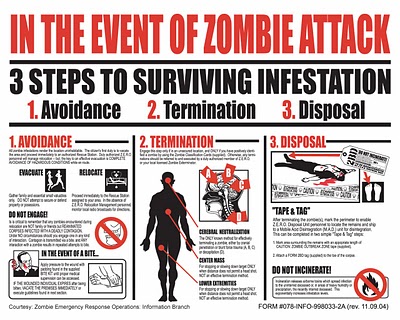
An emergency survival kit is a collection of supplies which have been prepared to aid in the survival of a disaster or emergency situation such as hurricanes, earthquakes, and other natural disasters. A good emergency survival kit contains tools to provide the basic survival necessities such as shelter, food, water, and first aid. It this case we want to prepare a kit specialized for a zombie encounter.
There a few types of survival kits; stashes, mini-kits and bug-out kit. A stash is a large collection of horded food and supplies usually set up for long term use under siege situations. Mini kits hold basic supplies and are designed to fit in small places such as a motor vehicle. Bug-out kits are portable survival kits also known as “Personal Emergency Relocation Kits”; these are used for quick escape and survival for a few days. Bug-out kits usually also contain tools that aid in gathering resources for more prolonged times after limited supplies run out.
Before creating an emergency zombie survival kit or kits you must ask yourself a few questions: What type of kit should I make? How many people will I be providing for? Where should I keep my kit? How much food and water do need? Where would I go under extreme conditions? ECT… Look at your surroundings. If a zombie outbreak were to happen right now are you in a safe location. This is a great deciding factor for preparing your kit. Think of any situation that could happen and consider preparation for the most probable dangers. What will you need in your kit? Every situation is different for everyone and kits can be modified for specific purposes.
Location matters, it might be smart to keep smaller emergency survival kits in your car or at work. Also you might want to keep different styles of kits depending on your location, for example: If you live in the mountains away from large populations in a fairly zombie proof home you might consider keeping a long term stash. On the other hand if you live in an inner city location in a not so zombie proof home you might want to rely more on a light bug-out kit to get you to a safer location.

Basic Tools and Supplies
 Before specializing in any type of zombie survival kit for emergency situations it is important to know what items are needed for basic survival. To set up a good survival kit foundation you should know what the most fundamental items needed in almost all disaster situations are. There is a list from the homeland security website;
Before specializing in any type of zombie survival kit for emergency situations it is important to know what items are needed for basic survival. To set up a good survival kit foundation you should know what the most fundamental items needed in almost all disaster situations are. There is a list from the homeland security website;
Recommended Items to Include in a Basic Emergency Supply Kits:
-Water, one gallon of water per person per day for at least three days, for drinking and sanitation
-Food, at least a three-day supply of non-perishable food
-Battery-powered or hand crank radio and a NOAA Weather Radio with tone alert and extra batteries for both
-Flashlight and extra batteries
-First aid kit
-Whistle to signal for help
-Dust mask, to help filter contaminated air and plastic sheeting and duct tape to shelter-in-place
-Moist towelettes, garbage bags and plastic ties for personal sanitation
-Wrench or pliers to turn off utilities
-Can opener for food (if kit contains canned food)
-Local maps
Additional Items to Consider Adding to an Emergency Supply Kit:
-Prescription medications and glasses
-Infant formula and diapers
-Pet food and extra water for your pet
-Important family documents such as copies of insurance policies, identification and bank account records in a waterproof, portable container
-Cash or traveler’s checks and change
-Emergency reference material such as a first aid book survival manuals
-Sleeping bag or warm blanket for each person. Consider additional bedding if you live in a cold-weather climate.
-Complete change of clothing including a long sleeved shirt, long pants and sturdy shoes. Consider additional clothing if you live in a cold-weather climate.
-Household chlorine bleach and medicine dropper – When diluted nine parts water to one part bleach, bleach can be used as a disinfectant. Or in an emergency, you can use it to treat water by using 16 drops of regular household liquid bleach per gallon of water. Do not use scented, color safe or bleaches with added cleaners.
-Fire Extinguisher
-Matches in a waterproof container
-Feminine supplies and personal hygiene items
-Mess kits, paper cups, plates and plastic utensils, paper towels-Paper and pencil
-Books, games, puzzles or other activities for children
 These items are great for a basic kit. Creating an emergency survival with these supplies would be great for smaller S 1 or maybe even S 2 zombie emergencies. These are usually caused by a low grade zombie and everything is usually controlled and back to normal after a few days. Just board up your windows and doors and wait it out.
These items are great for a basic kit. Creating an emergency survival with these supplies would be great for smaller S 1 or maybe even S 2 zombie emergencies. These are usually caused by a low grade zombie and everything is usually controlled and back to normal after a few days. Just board up your windows and doors and wait it out.
In larger zombie outbreaks or outbreaks caused by higher grade zombies, the situation gets dramatically worse. It is unlikely that a small survival kit is enough to handle a large zombie up rising. A larger stash would allow you to last quite a bit longer check out the under siege section for more details. Most likely unless you have a self sustaining fortress you will need to Transport to a safer location.
Zombie Survival Kit
 Unlike most disasters the biggest difference is that in almost any zombie emergency situation some degree of combat is involved. In order to have the advantage in zombie combat, it is important to have some kind of weapon in your emergency zombie survival kit. As stated before every situation is different and additions to the basic kit should follow the specific situation.
Unlike most disasters the biggest difference is that in almost any zombie emergency situation some degree of combat is involved. In order to have the advantage in zombie combat, it is important to have some kind of weapon in your emergency zombie survival kit. As stated before every situation is different and additions to the basic kit should follow the specific situation.
Bug out kits should be kept light considering that some of the time on foot might involve running away from hordes of zombies. If additional clothes are in the kit they should be tight fitting and hair should be short or tied down to prevent being snagged by undead fingernails.
Do research on different types of items and see what is best for your particular situation. Try to get items that are useful in more that one situation. For example an axe is great for chopping wood but it is also good at chopping zombie flesh. A crowbar is a good weapon but can also be used to pull out nails or “jimmy” doors, or even aid in climbing.





